Inserting and preparing to use Melodyne
The following tour will show you how to integrate Melodyne into Reaper.
Required versions and compatibility
To enjoy the advantages of Melodyne with ARA in Reaper, you require at least Reaper Version 5.97 and Melodyne Version 4.2 as a VST3 plug-in.
In the Reaper program settings for VST plug-ins, you can switch ARA support on or off. By default, it is switched on.
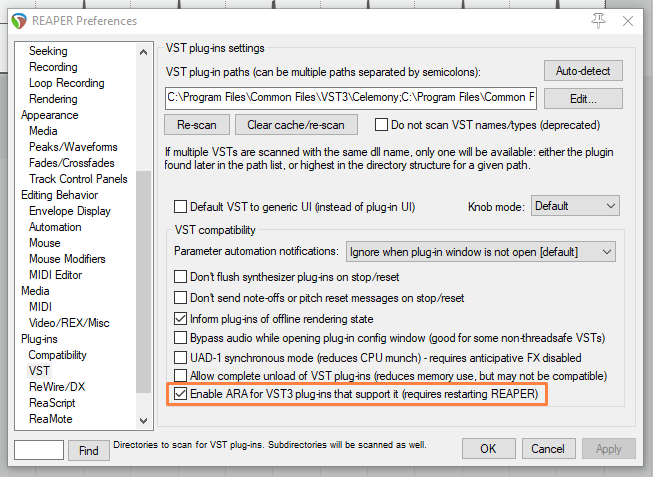
If you open older projects, in which you had used Melodyne as a transfer plug-in, Melodyne will continue to be integrated as a transfer plug-in. You will find that all your Melodyne editing has been preserved and you can continue where you left off. When starting new projects, however, ARA is available.
Loading Melodyne
In Reaper, you can load Melodyne in either of two ways: either as a “Track-FX”, in which case it affects the entire track, or as an “Item-FX”, in which case it affects one Media Item only. We recommend you to integrate Melodyne with ARA always as “Track-FX” for the entire audio track.
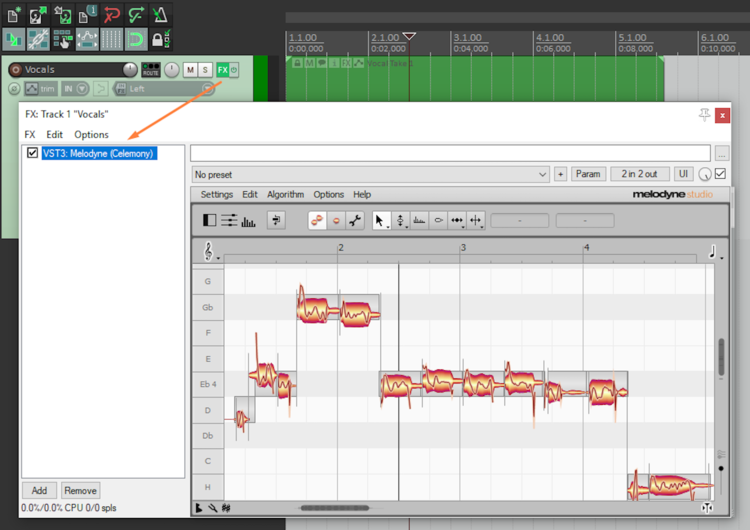
Please note that the Melodyne plug-in must invariably occupy the first insert slot in the channel strip and is automatically moved there if you insert it into another slot. This prevents the other plug-ins you are using on the track from operating destructively.
For now, insert the Melodyne plug-in. If there is already a Media Item on the audio track, you will see its contents in Melodyne and can set to work at once editing the notes.
Without ARA, you would have had to play through the entire track at this point in order to transfer it to Melodyne. With ARA, this is no longer necessary.
Multi-window vs. single window operation
Like other plug-ins with which you are no doubt familiar, Melodyne opens a separate window for each track into which it is inserted.
You can position and resize these Melodyne windows at will. To resize a Melodyne window , drag its bottom right-hand corner.

To avoid an avalanche of windows, you can set Reaper to open a single window only. To do this, check “Only allow one FX chain open at a time” in the plug-in settings.
If you wish the Melodyne window to remain open at all times in the Reaper doc, you should also check the option “Auto-dock new FX chain windows”.
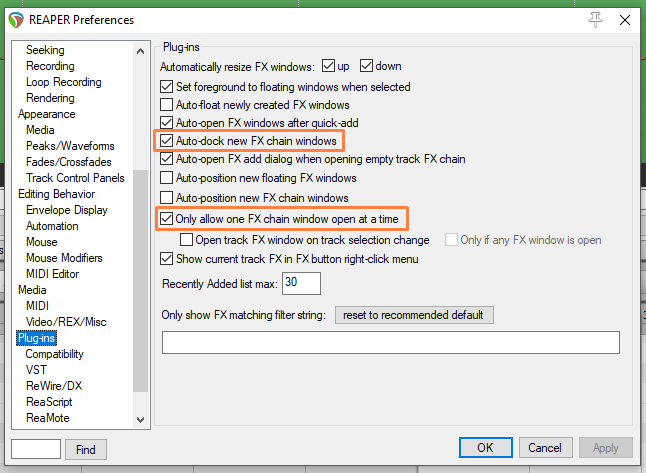
Keyboard shortcuts
Whereas under Windows, the keyboard shortcuts CTRL+A/C/X/V are automatically passed on to Melodyne, to ensure the same result on a Mac you must go to Reaper’s FX menu and check the option “Send all keyboard input to plug-in”.
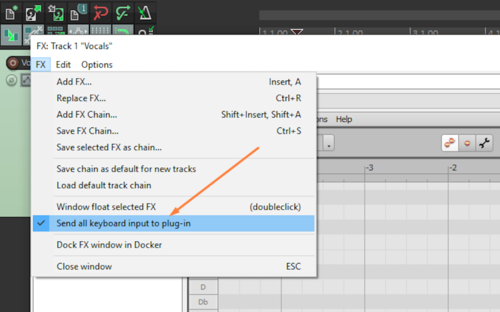
Integration of the Undo function into Reaper
With the option “Save minimal undo states” in Reaper shown here, you can select whether or not the undoing of Melodyne editing steps should be integrated into Reaper’s own Undo history.

If you leave the option unchecked, you can undo editing steps in Melodyne not only from within Melodyne but also using Reaper’s own Undo function. That can be convenient but it has its drawbacks, as it means Melodyne has to send a large quantity of data to Reaper after each editing step, which can slow things down when you are working with Melodyne.
For this reason, we recommend you to check (i.e. select) the option shown. Admittedly this prevents you undoing Melodyne editing steps from within Reaper, but you can still undo them from within Melodyne. The time-consuming transfer of data to Reaper is thereby avoided, which makes working with Melodyne considerably more fluid and agreeable.
Since Reaper Version 5.972, this is the default setting.
Bypassing or removing Melodyne, and comparing your editing with the original file
To switch Melodyne to bypass or remove it from a Media Item, deactivate or delete Melodyne from “Track FX”. Of course, if you switch Melodyne to bypass, time-stretching will no longer be performed by Melodyne but by Reaper, which can lead to differences in the sound.
In addition to Reaper’s bypass function, which deactivates Melodyne altogether, Melodyne’s “Compare” button offers you a quick way of comparing the current state of your editing with the original audio files.
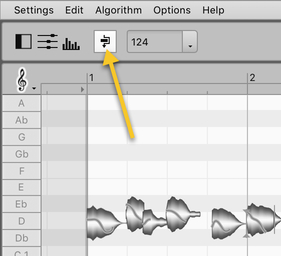
The Compare switch resets the notes – not only acoustically but also visually – to their unedited state. This lets you see at a glance which notes have, and which have not, been affected by your editing.
The Compare switch invariably affects all Media Items governed by Melodyne, whichever track they are on, and regardless of whether or not they are currently visible in the Note Editor. The entire song is then temporarily returned to the state it was in before you began modifying notes with Melodyne.
Any adjustment of the tempo of Media Items to match that of the song is also reversed.
Tip: Working with long files
With ARA, Melodyne always analyzes in its entirety the audio file that is being referenced by a media item, even if you have narrowed the item’s boundaries before using Melodyne. This has several advantages. It allows you, for instance, to widen the item boundaries again later without any further analysis by Melodyne being required.
It does mean, however, that there can be a noticeable hold-up when Melodyne is first used on a media item; this would be the case, for example, if the audio file being referenced by the item was a live recording lasting several hours (which Melodyne would analyze with the Polyphonic algorithm).
So if you just want to edit part of such a recording, we recommend that, before you begin editing with Melodyne, you convert the passage in question into a new item (File>Render>Selected Media Items). This will then be based on a new, shorter audio file that Melodyne will be able to analyze that much faster.
Saving, archiving and passing on your songs
Thanks to ARA, when saving and archiving your work, it is not necessary to give special thought to Melodyne, because all the files used by Melodyne (which it will need again when the song is next opened) are stored in the Reaper project.
If, however, you are passing on your Reaper project to third parties – for remixing, for example – you do then need to make sure that they also have at their disposal Version 4.2 (or higher) of Melodyne. Which actual edition of Melodyne the recipient possesses is not relevant. Should, for example, they only possess the “small” Melodyne essential, where you have been working with the “big” Melodyne studio, they will still hear all your Melodyne editing exactly as if they too had the studio edition. Naturally, if they propose to modify or add to your Melodyne editing of the song, they will be limited in the actions they can perform to the function set of the edition they possess.
It cannot hurt, however, to render your tracks before sharing your work with others. This may be advisable for other reasons too, such as any use you may have made in your project of third-party plug-ins.
Buffer size
We recommend an audio buffer size of 1,024 samples. Smaller values lead to a marked increase in the CPU load. Should you require a smaller buffer, e.g. when you are performing the headphone mix directly in your computer and not monitoring via an external channel strip or mixer, switch all instances of Melodyne during the recording to bypass. Reactivate Melodyne as soon as you begin editing your new track.